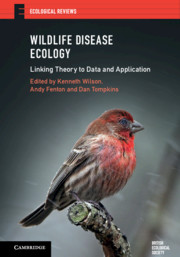Book contents
- Wildlife Disease Ecology
- Ecological Reviews
- Wildlife Disease Ecology
- Copyright page
- Contents
- Contributors
- Preface: Wildlife Disease Ecology
- Glossary of Terms
- Part I Understanding within-host processes
- Part II Understanding between-host processes
- Part III Understanding wildlife disease ecology at the community and landscape level
- Chapter Fifteen The ecological and evolutionary trajectory of oak powdery mildew in Europe
- Chapter Sixteen Healthy herds or predator spreaders? Insights from the plankton into how predators suppress and spread disease
- Chapter Seventeen Multi-trophic interactions and migration behaviour determine the ecology and evolution of parasite infection in monarch butterflies
- Chapter Eighteen When chytrid fungus invades: integrating theory and data to understand disease-induced amphibian declines
- Chapter Nineteen Ecology of a marine ectoparasite in farmed and wild salmon
- Chapter Twenty Mycoplasmal conjunctivitis in house finches: the study of an emerging disease
- Chapter Twenty-one Processes generating heterogeneities in infection and transmission in a parasite–rabbit system
- Chapter Twenty-two Sylvatic plague in Central Asia: a case study of abundance thresholds
- Index
- Plate Section (PDF Only)
- References
Chapter Sixteen - Healthy herds or predator spreaders? Insights from the plankton into how predators suppress and spread disease
from Part III - Understanding wildlife disease ecology at the community and landscape level
Published online by Cambridge University Press: 28 October 2019
- Wildlife Disease Ecology
- Ecological Reviews
- Wildlife Disease Ecology
- Copyright page
- Contents
- Contributors
- Preface: Wildlife Disease Ecology
- Glossary of Terms
- Part I Understanding within-host processes
- Part II Understanding between-host processes
- Part III Understanding wildlife disease ecology at the community and landscape level
- Chapter Fifteen The ecological and evolutionary trajectory of oak powdery mildew in Europe
- Chapter Sixteen Healthy herds or predator spreaders? Insights from the plankton into how predators suppress and spread disease
- Chapter Seventeen Multi-trophic interactions and migration behaviour determine the ecology and evolution of parasite infection in monarch butterflies
- Chapter Eighteen When chytrid fungus invades: integrating theory and data to understand disease-induced amphibian declines
- Chapter Nineteen Ecology of a marine ectoparasite in farmed and wild salmon
- Chapter Twenty Mycoplasmal conjunctivitis in house finches: the study of an emerging disease
- Chapter Twenty-one Processes generating heterogeneities in infection and transmission in a parasite–rabbit system
- Chapter Twenty-two Sylvatic plague in Central Asia: a case study of abundance thresholds
- Index
- Plate Section (PDF Only)
- References
Summary
How and why do predators sometimes fuel disease outbreaks but other times thwart them? Answering this could help explain spatial and temporal variation in disease and could explain why attempts to control disease by manipulating predators sometimes fail. We give eight mechanisms by which predators can suppress/spread disease in prey populations, exploring each generally and reviewing evidence from the study system that has been the focus of much of our research. This system focuses on Daphnia dentifera, a dominant herbivore in lake food webs in the Midwestern United States. D. dentifera is prey to bluegill sunfish and phantom midge larvae, as well as host to a virulent fungal pathogen. We review evidence for bluegill sunfish as ‘healthy herds’ predators that reduce disease, and for midge larvae as ‘predator spreaders’ that fuel disease outbreaks. We find that both predators can impact disease via multiple mechanisms. Bluegill feed selectively on infected hosts and also depress disease in Daphnia by reducing the density of midge larvae which spread disease. They also increase the abundance of Ceriodaphnia, which reduce disease. Midge larvae increase disease in their hosts, in part by releasing spores into the water column where they can be consumed by additional hosts.
Keywords
- Type
- Chapter
- Information
- Wildlife Disease EcologyLinking Theory to Data and Application, pp. 458 - 479Publisher: Cambridge University PressPrint publication year: 2019
References
- 6
- Cited by



